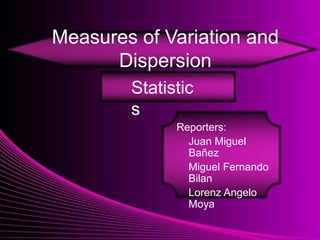
Measures of variation and dispersion report
- 1. Measures of Variation and Dispersion Statistic s Reporters: Juan Miguel Bañez Miguel Fernando Bilan Lorenz Angelo Moya
- 2. Range The simplest and crudest measure of dispersion is the range. This is defined as the difference between the largest and the smallest values in the distribution. If are the values of observations in a sample, then range (R) of the variable X is given by: Formula: R = H.S. – L.S. R = U.B. – L.B.
- 3. Examp Class Interval F <CF le 98 – 100 2 40 * The range of the set of 95 – 97 1 38 scores : 11, 13, 12, 14, 15range92 – 94 of scores : 11,37 * The of the set 1 13, 12, 14, 15 R = U.B. – 89 – 91 6 36 L.B. R = – 88 – L.S. 6 86 H.S. 30 R = 15 – 11 83 15 – R = – 85 11 5 24 R=4 R=4 80 – 82 9 19 77 – 79 2 10 74 – 76 3 8 74 – 73 5 5 N = 40
- 4. Quartile Deviation The inter-quartile range isspecial A measure similar to the frequently range (Q) to the inter-quartile range reduced is measure of semi- . It is the difference betweenas the interquartile range, known the quartile deviation) (QD), by first third quartile (Q3 and the dividing it quartile (Q1). by 2. Formula: Q3 – Q1 Q.D. =I.R. = Q –Q 3 1 or I.R. 2 2
- 5. Mean Deviation The mean deviation is an average of absolute deviations of individual observations from the central value of a series. Average deviation about mean Formula: M.D. = ∑ X – X N
- 6. Examp b.) a.)the entries the mean: using X and f X Add Calculate in column X – the formula Calculate the mean by – le x = ∑X means we are going = add x = ∑fx . This = 10+12+12+14 = 48 to 12 X the entries in columnthe mean deviation of the Find Ffx.X X F N ∙ 4 m– X X F Xm – X following ungroup frequency 24 17 MD = ∑f X – 34 distribution: 2.52 42.84 3 X12 36 1.52X = ∑X 18.24 Add the column X X – X X –X M.D. =∑ X – X 4 19 a. X76 10 12 12 14 N9.88 N 0.52 5 2810 ) 1402 4 0.48 = 47913.44 =b. X 2 3 4 5 6 7 8 141.8 6 1912 ) 1140 1.48M.D. = 428.12 F 17 12 19 28 19 9 2 7 9 12 63 0 2.48106 422.32 106 8 2 14 16 2 3.48X ≈ 4.526.96 =1 MD ≈ 1.32 N = 106 ∑fX = X – X 12.48 ∑ 479 ∑f Xm – X = =4 141.8
- 7. Standard Deviation Standard deviation is the positive square root of the mean-square deviations of the observations from their arithmetic mean. Formula: S2 = ∑ (X – X)2 N- 1
- 8. Examp a.) The mean price is : c.) Add the column ( x – x ) and 2 X (x–x) 2 xle = ∑fX = 90+73+78+79+83+95+77+79+74+82 = 810 = 90 81 sum up the scores. P 81 73 64 N The price of a 250 gram-soap powder of 10 b.) The range of theleading is 95 –was=recorded from 10 10 a prices brand 73 78 P22 9 supermarkets. The prices (in pesos) 2 = ∑( x – x)2 = 427 79 4 S were: ≈ 47.44 83 4 N – 1 90, 10 78, 79, 83, 95, 77, 196 74, 73, 95 79, –1 82 77 16 S = √47.44 ≈ 6.89 Find : 79 4 a.) The mean 74 price 49 b.) the range of the prices 0 81 ∑(x – x)2 = 427 c.) the standard deviation of the prices
- 9. Standard Deviation for Group Data The formula used in the computation of the standard deviation which is the mean deviation method, will be very difficult to deal with when the mean is a decimal number as shown example in Mean Deviation. There is an easier way by which the variance and standard deviation can be derived from the previously used formula. This method of computing the variance and standard deviation is called the “raw score Formula: . method” For Grouped Frequency For Ungrouped Data Distribution S2 = N∑X2 – (∑X)2 N (N – 1) S2 = N∑fXm2 – (∑fXm)2 For Ungrouped FrequencyN (N – 1) Distribution S2 = N∑fX2 – (∑fX)2
- 10. Examp Calculate the means of the leandoffxdata.means of the Calculateentries in column x Add of data. set the the set . 2 2 X X2 X = ∑X = 48 = 12 10 100 Calculate the standard deviation2 using the raw X N score 4 Fx F method. X2 12 Fx 144 X = ∑fX = 479 = Substitute ∑fX17 a. 479 and ∑fX2 =12 14in the 144 = X 10 12 2433 2 34 4.5212 68 4 2 formula. 2 –)(∑fX)= 106(2433) – (479)2 Add N∑fX 12S2 column x2 S = the entries inX 2 3 4 9 5 6 108 196 898 – 2 3 36 b. all the scores and square 229 441 14 7 257 = 8 N 4 get the ( N F 1) 76 12 19 28 = 304 2 = 584 and )19 – N sum. 17 106 19 ∑X 2 16∑X 9 5 28 140 2 25 48 700 11130 Substitute ∑X = 48 and = √2.56 ≈ in the = 2.56 ∑X = 584 6 11130 114 19 2 36 684 S2 =formula.– (∑X)S21.594(584) – (48)2 = 2336 – N∑X2 = 7 9 2304 63 49 441 N ( N – 1) 8 2 16 64 128 4 ( 4 – 1) N = 12 ∑fX = √2.67 ≈ ∑fx2 = ≈ 2.67 = 106 1.63 479 2433
